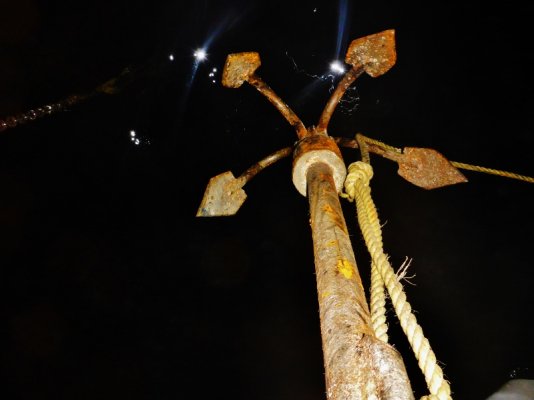For deep water anchoring 50/50 chain , then nylon seems the best combination.
For 200 deep water few would have aboard the weight of 600-700 ft of chain , but perhaps 200 ft of chain then a suitable nylon is easy to carry aboard.
I would suggest you think
very carefully before anchoring in very deep (200') water. Most of our windlasses do
not have the power to bring that much chain and a decent anchor (never mind the 100+# or so of mud or muck on the anchor) straight up from 200'.
Should it get fouled at 125 feet plus, you will not be able to send someone down to free it, so in both these cases you might lose the whole rig.
Most folks I know consider seventy feet to be a max anchoring depth for a non commercial vessel. @ 200 feet of chain, that's on the fine edge an acceptable 3:1 scope, for calm water anchoring.
My #2 has 350' of 1 1/4" double braid nylon and 50' of chain, so in an emergency, I might get my pick to hold in 125 feet of water for a short time, in good weather.
On the other hand, having a really good anchor (in my opinion a Rocna) suitably sized for your rode is most important.
Case in point, on New Year's Eve we pulled into Clifton, Union Island, SVG, just to clear in. The place was as crowded as I had ever seen it with some moorings having 3 or 4 catamarans rafted up on them, and it seemed every available spot was taken.
I finally found a tiny hole that would do for our two-hour stay, so I dropped the gear in 40 feet of water. At 60' the chain fouled in the chain locker and there I was with 1:1.5 scope in 20 knots of wind, unable for the moment to let out any more chain or bring up my anchor. As I stood on the foredeck visualizing the path our 53' boat was going to take through this mass of anchored and moored boats, with 60' of anchor chain dragging along, she rounded up and sat perfectly on the gear. 1.5 scope in 20 knots and she was holding! Unbelievable!
We cleared the obstruction, let out the proper scope, and all was well. Had we had an oversized anchor with lighter chain, I fear the anchor would not have set. Had I been using
any other anchor I'm sure it would not have held on that short scope.
The art of anchoring is about having an anchor and rode sized appropriately to each other and the boat. A 125 # anchor on 3/8" chain is a huge mismatch, just as bad as having a 25# anchor on 1" chain. It is a "team" effort, there is no star on the anchoring team.

